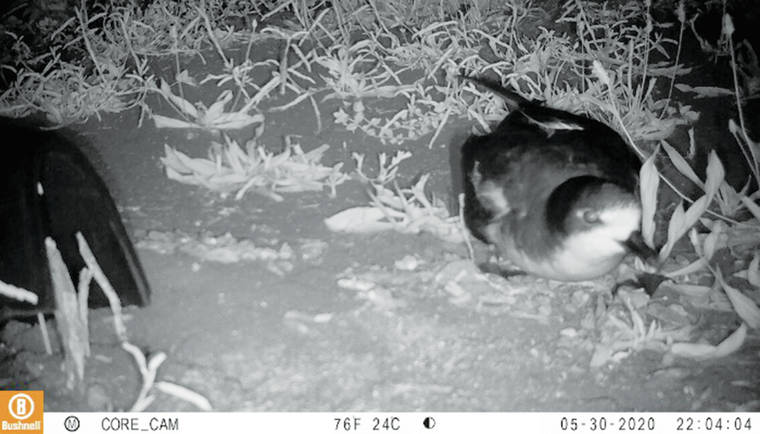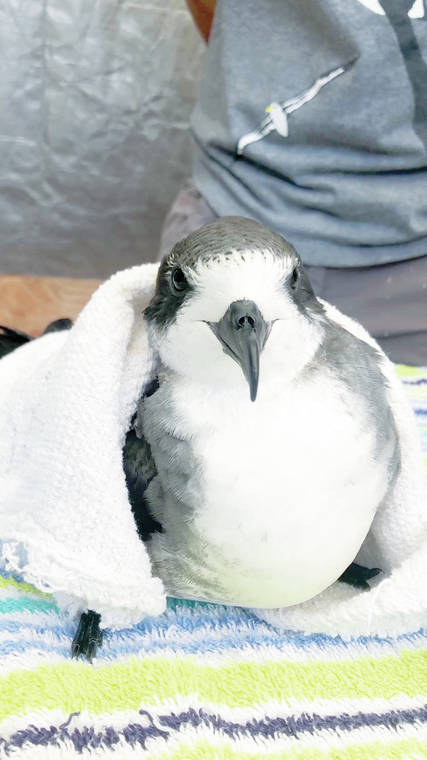KILAUEA — The first of 87 birds translocated as chicks and fledged from the protected seacliffs of Nihoku at Kilauea Point National Wildlife Refuge has returned after several years at sea.
It’s a critical milestone in an historic effort to save the endangered Hawaiian petrel (Pterodroma sandwichensis), or ‘ua‘u, and one that had been anxiously awaited by project partners.
The sighting of this individual, via trail-camera footage, is an early sign that this and other young birds that fledged from Nihoku between 2015 and 2019 successfully imprinted on the site and now may start returning to breed, just as conservationists had anticipated.
Project partners hope that additional individuals will be lured in by the use of “social attraction” — with the species’ calls played over a sound system — and that they will make use of artificial nest boxes installed within the protective fencing. The ultimate goal is to establish a thriving, new colony safe from predators.
After chicks leave the nest burrow, Hawaiian petrels and many other seabirds typically spend several years foraging on the high seas as they mature to breeding age, then return to breed at the site where they fledged. This returning Hawaiian petrel appears to have done just that, according to project partners.
It was spotted during an early July review of trail-camera footage periodically checked by project partners. The bird’s visit to Nihoku occurred on May 30. The presence of leg bands on the bird confirm a high probability that this is one of the birds translocated to Nihoku four or five years ago.
“We are thrilled to learn of this bird’s return,” said Dr. Lindsay Young, executive director of Pacific Rim Conservation.
“This is an indication that our efforts in the translocation project to bring chicks to imprint on the site is bearing fruit, providing the right cues that lead birds to this safe haven. The ultimate goal is to establish a thriving breeding colony of Hawaiian petrels within the fully enclosed, fenced area, to protect the breeding birds from invasive predators. This petrel marks the first critical step toward achieving that outcome,” said Young.
The Nihoku Ecosystem Restoration Project is a multi-partner effort involving Pacific Rim Conservation and the Kaua‘i Endangered Seabird Recovery Project, and is a state Department of Land and Natural Resources Division of Forestry and Wildlife project administered by the Pacific Cooperative Studies Unit, Kilauea Point National Wildlife Refuge, U.S. Fish and Wildlife Service and American Bird Conservancy.
The project is part of a larger, island-wide effort to restore populations of the Hawaiian petrel and another threatened and culturally important species, Newell’s shearwater ITAL (Puffinus newelli), or ‘a‘o.
As was done in this project, translocating birds to protected habitats from locations where they were vulnerable to threats such as invasive predators, is one important approach that is being implemented to help recover declining populations of Hawaiian seabirds.
Other tactics include control of invasive predators, habitat management, fencing, reducing power-line collisions, and fostering awareness within the island community on the issue of light attraction’s fatal effects on seabirds. Both petrels and shearwaters can become disoriented by light during their fledging flights and thus are highly vulnerable to collisions.
Dr. André Raine, project leader for the KESRP team, monitors seven nesting areas in Kaua‘i’s remote mountains, and says there have been major population declines in the two species, with the Hawaiian petrel declining by 78% and Newell’s shearwater by 94% between 1993 and 2013.
Over the last five years, the KESRP team has located and monitored ‘u‘au and ‘a‘o burrows in the mountains, then transported vulnerable chicks via helicopter to Nihoku just before the critical stage when they become imprinted on the new site to which they will later return to nest.
The translocated chicks are fed by Pacific Rim Conservation’s animal-care team, which provides feeding, care and monitoring of the chicks until they fledge from the site and head out to sea.
Since 2015, the team has successfully fledged 87 Hawaiian petrels and 67 Newell’s shearwaters from Nihoku. The ultimate proof that the project is successful will be the presence of breeding pairs at the site, a milestone that the project partners are eagerly awaiting.
“After so many years of hard work in the mountains and at Nihoku by everyone in this project, it is hard to put into words exactly how exhilarating it is to see this special bird appear on camera at the site,” said Raine.
“I literally jumped out of my seat and yelled with excitement when I saw the image for the first time, startling everyone around me. Considering all of the threats this species faces on Kaua‘i, their future on the island will only be assured if we use every conservation tool in our arsenal, including creative techniques like the translocation and social-attraction project at Nihoku.”
“We are thrilled to reach such a momentous occasion in this ongoing important recovery project,” said Heather Abbey Tonneson, refuge manager for the Kaua‘i National Wildlife Refuge Complex. “We look forward to continuing to work closely with our partners on this project to help our endangered-seabird populations soar toward recovery.”
“This is a huge step forward, and more confirmation that Hawaiian birds can be saved with effort and creativity,” said ABC President Mike Parr.
“It’s been a long wait to see the first petrel return to the protected habitat, but the science said it would. A new nest and chick would be an even bigger cause for celebration. That’s what we hope will be next.”
“The return of the first translocated Hawaiian petrel to the Nihoku site at Kilauea Point National Wildlife Refuge is an incredibly important milestone for this partnership,” said Jeff Trandahl, executive director and CEO of National Fish and Wildlife Foundation, a long-time supporter of this project.
“This sighting also provides initial evidence that the protected location is attractive to returning translocated petrels and shearwaters, and hopefully will ultimately result in nesting and the establishment of the first fully protected coastal colony for these species in Hawai‘i,” said Trandahl.
•••
Jessica Else, editor-in-chief, can be reached at 245-0457 or jelse@thegardenisland.com.







Great work!!!! Hope to see more successes just like this. Congrats!